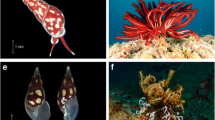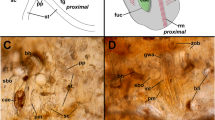Abstract
The opisthobranch gastropod Berthellina citrina (Ruppel and Leuckart, 18281) was collected from shallow water in the Gulf of Elat (Red Sea), where it is encountered only on sandy substrata overlaid with stones. The mollusc is nocturnal, feeds on various types of sponges, and hides during the day under stones. It releases an acid secretion (pH 1) containing sulphate and chlorine ions. This secretion is released, as a response to stimulation, from the entire body surface. In histological sections stained by standard dyes, the secretory cells remain colorless. In controlled laboratory experiments, it was found that this acid secretion protects B. citrina against all tested sea anemones, fishes, and crustaceans.
Similar content being viewed by others
Literature Cited
Arey, L.: Physiology of the repugnatorial glands of Onchidium. J. exp. Zool. 77, 251–286 (1937).
— and L. Barrick: Structure of the repugnatorial glands of Onchidium. J. Morph. 71, 493–522 (1942).
Crozier, W. and L. Arey: Onchidium and the question of adaptive coloration. Am. Nat. 53, 415–430 (1919).
Dunk, R., R. A. Mostyn and H. C. Hoare: The determination of sulphate by indirect atomic absorption spectroscopy. Atom. Absorp. Newsl. 8 (4), 79–81 (1969).
Edmunds, M.: Defensive adsptations of Stiliger vanellus Marcus, with a discussion of the evolution of nudibranch molluses. Proc. malac. Soc. Lond. 37, 73–81 (1966).
—: Opisthobranchiate Mollusca from Ghana. Proc. malac. Soc. Lond. 38, 83–100 (1968a).
—: Acid secretion in some species of Doridacea. Proc. malac. Soc. Lond. 38, 121–133 (1968b).
Engel, H. and C. J. Van-Ecken: Red-Sea Opisthobranchia from the coast of Israel and Sinai. Bull. Sea Fish. Res. Stn Israel 30, 15–34 (1962).
fontaine, A. R.: Secretion of highly sulphated acid mucopolysaccharides by the brittle-star Ophiocomina nigra. Nature, Lond. 176, 606–607 (1955).
—: The integumentary mucus secretion of the ophiuroid Ophiocomina nigra. J. mar. biol. Ass. U.K. 44, 145–162 (1964).
Gohar, H. A. F. and I. A. Abul-Ela: The development of Berthellina cetrina. Publs mar. biol. Stn Ghardaqa 9, 69–85 (1957).
Hayes, F. and D. Pelluet: The inorganic constitution of molluscan blood and muscle. J. mar. biol. Ass. U.K. 26, 580–589 (1947).
Humason, G. L.: Animal tissue techniques, 569 pp. San Francisco: Freeman & Co. 1967.
Marcus, E.: Some Opisthobranchia from Micronesis. Malacologia 3, 263–286 (1965).
Nicol, J. A. C.: The biology of marine animals, 699 pp. 2nd ed. London: Pitman & Sons Ltd. 1967.
O'Donoghue, C. H.: Report on the Opisthobranchiata (Report on material collected by the Cambridge expedition to the Suez Canal 1924). Trans. zool. Soc. Lond. 6, 713–841 (1929).
— and K. M. White: A collection of marine molluses, mainly opisthobranchs from Palestine. Proc malac. Soc. Lond. 24, 92–96 (1940).
Oren, O. H.: A note on the hydrography of the Gulf of Eilath. Bull. Sea Fish. Res. Stn Israel 30, 3–14 (1962).
Paine, R. T.: Food recognition and predation on opisthobranchs by Navanax inermis. Veliger 6, 1–9 (1963).
Pearse, A. G. E.: Histochemistry, theoretical and applied, 672 pp. 3rd ed. Boston: Little Brown Co. 1968.
Perrier, R. et H. Fisher: Les glandes palliales de defense chez Scaphander lignorius. C.r. hebd. Séanc. Acad. Sci., Paris 146, 1163–1166 (1908).
Robertson, J. D.: Ionic regulation in some marine invertebrates. J. exp. Biol. 26, 182–200 (1949).
Thompson, T. E.: Defensive acid-secretion in marine gastropods. J. mar. biol. Ass. U.K. 39, 115–122 (1960a).
—: Defensive adaptation in Opisthobranchia. J. mar. biol. Ass. U.K. 39, 123–134 (1960b).
—: Acid secretion in British cowries. Proc. malac. Soc. Lond. 34, 210–211 (1961).
—: Epidermal acid-secretion in some marine polyclad Turbellaria. Nature, Lond. 206, 954–955 (1965).
—: Eastern Australian pleurobranchomorpha. J. zool. Lond. 160, 173–198 (1970).
— and J. Slinn: On the biology of the opisthobranch, Pleurobranchus membranaceus. J. mar. biol. Ass. U.K. 38, 507–524 (1959).
Thompson, T. G. and H. E. Wirth: The sulfate-chlorinity ratio in ocean waters. J. Cons. perm. int. Explor. Mer 6, p. 246 (1931).
Author information
Authors and Affiliations
Additional information
Communicated by O. Kinne, Hamburg
Rights and permissions
About this article
Cite this article
Marbach, A., Tsurnamal, M. On the biology of Berthellina citrina (Gastropoda: Opisthobranchia) and its defensive acid secretion. Mar. Biol. 21, 331–339 (1973). https://doi.org/10.1007/BF00381090
Accepted:
Issue Date:
DOI: https://doi.org/10.1007/BF00381090




